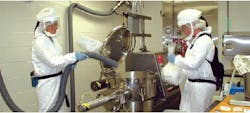Pharma facilities may not be thought of as environmentally hazardous work environments. After all, GMP and strict safety regulations prevail, and much attention is paid to avoiding cross-contamination.
Yet, the batch processing areas of drug development and pilot plants, particularly those that focus on tableting and solid dosage forms, can pose hidden hazards. And sometimes theyre not that hidden either for instance, when particulates are made airborne by an operator who doesnt know how to apply local exhaust ventilation effectively.
Hazardous active pharmaceutical ingredients (HAPI) arent the problem, either, explains Purdue University professor John McGlothlin, who has been studying particulate exposure for several years. Generally, the higher the ingredients potency, the more careful operators are about handling it, he says. Its the less potent materials that can accumulate to have a potentially adverse effect.
Given that a large portion of pharmas workforce is female and of childbearing age, protection is critical. But it also makes good economic sense, by preventing the cross-contamination that can destroy batches, as well as the waste that occurs when powders accumulate on the floor and must be vacuumed up.
Whats especially interesting about the work that McGlothlin and the 10 graduate students in his PEARL laboratory are doing, is the fact that they are applying video exposure monitoring, in a system that includes a sensor, wireless air sampling and video to analyze workplace hazards, and pinpoint the most troubling areas, in real time. Years ago, theyd used radio relay, but now wireless technology and the Internet are expanding the power and potential reach of this technique.
Users access the system via a specific IP address; sensor and video signals are conveyed simultaneously to a wireless laptop computer, where data are collected and analyzed. The cost is minimal, requiring only the computer, sensors, video camera and server, but the Web interface allows global access to real time data, and video, from anywhere in the world. Users can also archive and recall information and use it in future training materials or control systems.
What Purdue provides is proprietary software and a caching system, as well as data encryption. Its like a car kit, says McGlothlin.
The online monitoring technology wont eliminate the need for dedicated sampling, an expensive procedure that costs hundreds of dollars each time. But it allows one to use such sampling more strategically, and to place additional controls at high-risk process points.
Having such a visual tool has surprised even McGlothlin by what it has revealed. His team has found, for instance, that 90% of the exposure risk typically occurs at only 10% of the points within a given work area and cycle. In tableting operations, for example, the greatest risk of exposure tends to occur in mixing areas, in areas where ingredients are charged from drums into the mixer.
Typically, McGlothlin explains, a local exhaust system is placed near a mixer, but if the operator doesnt hold the exhaust hose at just the right position near the funnel, particulate concentration can quickly build up in the room. Its not a matter of being six inches or one foot off. says McGlothlin. Sometimes just a few inches make a big difference.
The key is consistency in placement of the hose, so that its close to the area where the powders are added, but not too close it should be at the edge of the scoop so that it doesnt intrude into the scoop.
Video exposure monitoring serves as an excellent training tool, McGlothlin says, but also offers automatic incentives and reinforcement for use of best practices. For example, if monitoring shows that operators have used best practices to lower exposure risks, they may not have to wear as much protective gear the next shift. When they dont use the right techniques, they must wear additional gear.
The project has evolved over time, and McGlothlin is working with the National Science Foundation (NSF) and the Center for Pharmaceutical Processing Research (CPPR) to commercialize the technology.
So far, each of the CPPRs 36 members has access to the video exposure monitoring system, and they are sharing findings every few months. McGlothlins lab is also applying the technology in a wide variety of other fields and industries, to monitor other environmental factors and responses, including noise and heart rate.






